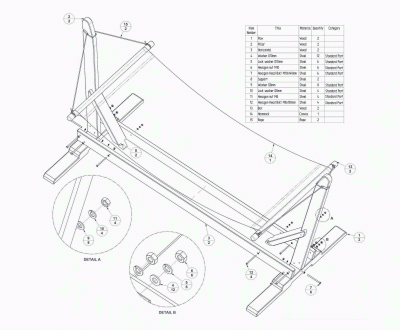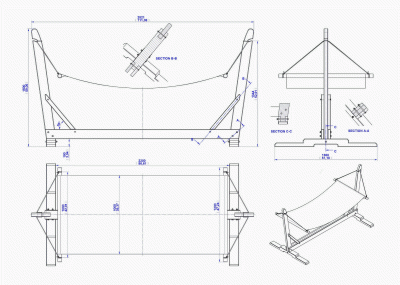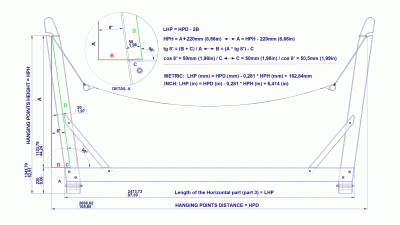We decided to present you an elegant wooden hammock stand of a very simple design, which can easily be made even in a less equipped workshops.
Connections between the parts are made with fasteners, so it can be quickly disassembled and stored in a protected, dry place during periods when not in use.
Hammock was developed by native inhabitants of tropical regions because of simple reason – to be elevated above the ground during the sleep to avoid stings and bites of various creatures on the ground like ants and snakes. Spanish colonists noted use of the hammock by Native Americans and quickly introduced it for use. Christopher Columbus brought the hammock to Europe, and the Europeans quickly realized its other practical value, aside for sleeping in the woods. At the end of 16th century hammock was adopted for use on sailing ships, because the hammock save he space and, unlike the ordinary bed, swinging together with the ship, so the sailors did not fell out of it. If we know that beds on ships had several bunks, we can only presume how useful the hammock to the sailors was.
Today, use of the hammocks is widely accepted by the campers, forest scientists and explorers, as well as for the relaxation and for the rest. It can often be seen on the beach, by the pool, in the country-houses and gardens. For additional comfort, the hammock can have pillows or mosquito net.

1300mm (51.18'') x 2821mm (111.08'') x 1500mm (59.06'')
Hammock types: There are several types of hammock: Spreader bar hammock, Mayan hammock, Brazilian hammock, Naval hammock, Venezuelan (Jungle) hammock, Travel hammock... Each type is distinctive and has its own advantages and disadvantages. Hammocks are made in various dimensions, patterns, colors and out of different types of materials, like: natural or synthetic fabric, string, netting...
Many types of hammocks can be purchased in stores or via internet and the common thing for all of them is that they have to be attached between two supports. For supports you can use two trees at a suitable distance, tree and wall of the house, the supports buried into the ground... These are the simplest solutions, but their shortage is that they are fixed, and sometimes it is very difficult to find and use two existing supports in the yard or a garden. If there is no suitable spot, where you could attach your hammock, then the hammock stand is the best solution for you. The hammock stand can be purchased, or you can make it by yourself. There are many types of the hammock stands that you can buy or make: metal hammock stand, wooden hammock stand, arc hammock stand, classic frame hammock stand.
Many hammocks come in a variety of types and sizes, so it is very difficult to design a universal hammock stand. Dimensions of the hammock stand depend on the size of the hammock, and whether hammock have or do not have spreader bars. Dimensions of the hammock stand also depend upon individual wishes and possibilities: depending on the available space in the yard or terrace and whether you want the hammock stand to dominate the garden or not... Our goal was to offer you the hammock stand plan with the wooden structure presented, and your task is to adjust it to your preferences.
Connection between dimensions of the hammock stand and the hammock dimensions: There are two types of hammocks – with or without spreader bars. Spreader bars are the wood or metal bars on each end of the hammock bed, spreading its width and allowing for easy access. In most cases the hammock stand fits to one or another variant of the hammock, but hammock without the spreader bars has higher curvature and must be attached higher, so the hammock stand construction has to be slightly different.


An important fact for the hammock hanging is the distance between the hanging points. For the hammocks with spreader bars, distance between hanging points should be equal to the overall length of the hammocks. If the distance between the hanging points on the hammock stand is larger, you will have to lengthen the overall length of the hammocks on both ends with the ropes or chains. The minimum hanging distance for hammocks without spreader bars is two thirds of the overall length of the hammock. Of course, these are just ours recommendations, which can be freely changed as needed. If the hanging distance is lesser than 2/3, then the curvature of hammock is higher and you will have to set the hanging points higher off the ground; if it is higher than 2/3, then the curvature is lesser and the hanging points can be closer to the ground. These facts clearly show the difference in the lying comfort, so it all depends on your wishes. Distance off the ground for the hanging points should be 1,2 – 1,5m (4-5 feet) for the hammocks with spreader bars, and 1,8 – 2,4m (6-8 feet) for the hammocks without spreader bars.
We recommend that you always use a hammock stand if you have a hammock with spreader bars. If you have a hammock without spreader bars (Mayan or Brazilian hammocks...), you can hang it on a hammock stand, or between the trees, etc. – but respect the criteria of the hanging points distances that we specified, otherwise you will most likely find yourself dipping so deep that you will connect with the ground.
As you can see in the hammock stand plan, the dimensions that we offer are adjusted for the simplest version of the hammock, which you can see on the picture of the finished hammock stand. If you decide to buy a hammock, you may need to change dimensions of a hammock stand to meet the criteria for the hammock hanging we mentioned above, since there are hammocks of various sizes and types on the market. The principle is as follows: based on overall length of your hammock, you can calculate the length of the Horizontal part (part 3); and based on the type of hammock you bought, you can determine the hanging points height. We hope that the criteria we have specified will be useful for these calculations. On the following picture you can see the process of the Horizontal part length (part 3) calculation.

Finished Hammock stand
Hammock stands can be made of different kinds of wood such as cypress, cedar, teak, eucalyptus and other hardwoods suitable for outdoor use. If you plan to keep the hammock outdoor, you can also use pressure treated wood, or you can protect wood with some oil or varnish. Depending upon the kind of wood you will use to make hammock stand, where you plan to set it and what climatic conditions you live in, you will need to devote more or less attention to the final processing of wood and the wood treatment. In the warm climate with more sunshine, you will need to treat the wood more frequently. If your wooden hammock stand will be exposed to the elements, it will require regular sanding with fine sandpaper, and treatment with some of the products for the wood protection, after each sanding. There are plenty products on the market, like linseed oil, mineral oil, etc. If you plan to keep the hammock in direct sunlight, it is wise to avoid fabric and ropes made of natural materials. Cotton and other natural materials are subject to fungus attack, so you should use synthetic fabric and ropes for this purpose.
It can be quite tricky to get in and out of hammock with the hammock stand. If some older person intends to use the hammock, it will be a good idea, to be always around to help. Children should be supervised at all the time when using a hammock to avoid and accidental entanglement in the ropes of the hammock or falls from hammock or construction of the hammock stand.
Unlike the metal hammock stands, the wooden ones are expensive, but they are far more stable because of their size and weight. And of course, the wooden hammock stands are much more beautiful.
Please, check the origin of the particular pieces of wood you want to purchase for hammock stand making since most of the wood species suitable for the outdoor use are critically endangered in their natural habitats because of the uncontrolled harvesting for commercial use. Make sure that wood you want to purchase do not belong to the endangered species, and does it come from the plantations, to avoid unwonted contribute to the devastation of life on earth.